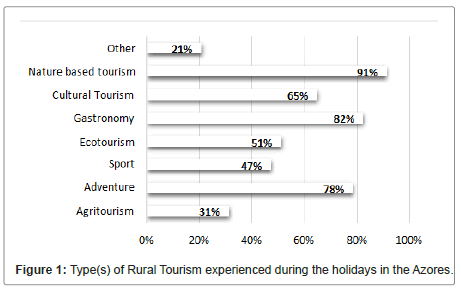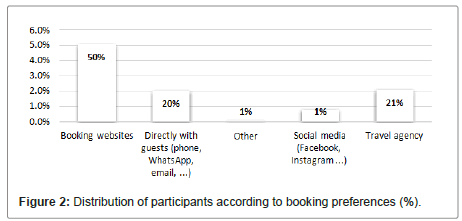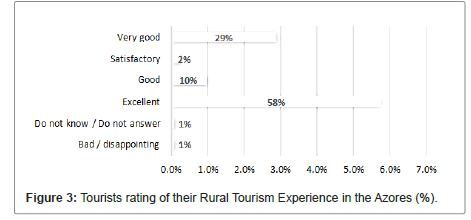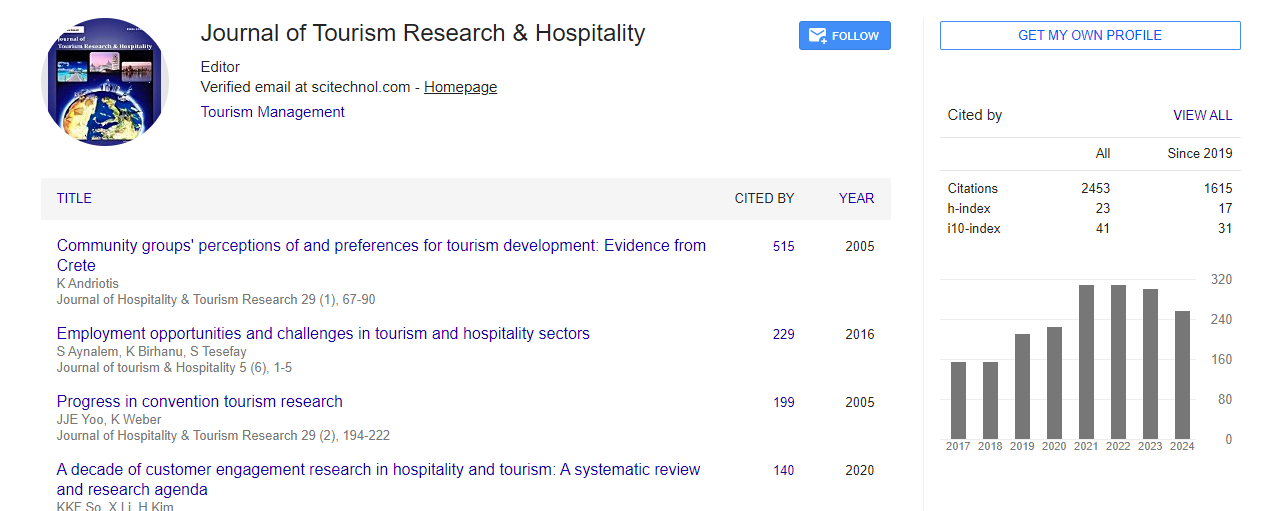Research Article, J Tourism Res Hospitality Vol: 12 Issue: 1
Assessing Rural Tourism Experiences: The Case of the Azores Region
Maria da Graça Batista*
Department of Applied Sciences, School of Business and Economics and CEEAplA, University of Azores, 9500-321 Ponta Delgada, Portugal
*Corresponding Author: Maria da Graça Batista
Department of Applied Sciences, School of Business and Economics and CEEAplA, University of Azores, 9500-321 Ponta Delgada, Portugal
Tel: +351918303417
E-mail: maria.gc.batista@uac.pt
Received date: 15 February, 2023, Manuscript No. JTRH-23-91686;
Editor Assigned: 17 February, 2023, PreQC No. JTRH-23-91686 (PQ);
Reviewed Date: 03 March, 2023, QC No. JTRH-23-91686;
Revised Date: 10 March, 2023, Manuscript No. JTRH-23-91686;
Published date: 20 March, 2023, 10.4172/2324-8807.10001010
Citation: Batista M da G (2023) Assessing Rural Tourism Experiences: The Case of the Azores Region J Tourism Res 12:1.
Abstract
This research paper focused on tourist’s experiences after engaging in a rural tourism experience, the activities developed during that period and what relevant factor were considered on planning the holidays. We collected data in the Azores, a region prone for rural tourism implementation. We were able to recognize that the landscape, adventure related activities and local gastronomy were some of the reasons tourists choose the Azores as a destination. The rural living experience and the local population welcoming traits were mentioned as factors that make tourists want to return to the Azores on holidays.
Keywords: Rural tourism; Perceptions; Regional studies; Tourism planning
Abbreviations
CatPCA: Categorical Principal Component Analysis; PCA: Principal Component Analysis
Introduction
Rural tourism is presented as a sustainable alternative to traditional tourism [1,2], allowing tourists to meet their preferences since it enables a differentiating and genuine experience [3-6]. It also allows tourist to immerse in the rural tourism experience [7,8]. The touristic experience is a complex psychological process that takes place and is initiated by the tourist itself [9]. The individual builds his/her experience according to his/her preferences and to his/her idealized scenario [10]. It can be a sports experience, a rustic experience, a gastronomic experience, or a mix of different relevant activities for the participants but they must be linked to that specific rural area [11-13].
Kastenholz, et al. refers the importance of enhancing tourist experiences for rural areas to surpass social and economic frailties and to make progress using the unique resources these regions have to offer [14]. Rural areas have also been subjected to an increasing touristic demand since urban live is full of stress and tourists are searching for activities that solve this type of problems [2,5,15]. This paper aims to analyze the type of experiences tourists have regarding rural tourism. It also intends to access the relevance of the activities developed during the holidays and how it relates to the planning of those holidays.
Materials and Methods
Our research is based on data collected about Azores tourist’ opinions regarding their holiday planning, their holiday experience and the activities developed during their stay to access their perceptions and to provide guidelines for improving the sustainable development of rural tourism. The methodological approach comprised four main stages: Questionnaire design, non-probabilistic data collection, data analysis and interpretation of outcomes, including the discussion of the results. The target population are anyone who are aged 18 or over, who has had at least one rural tourism experience in the Azores. The sample is composed of 125 participants who fulfill these conditions. Data was retrieved from September 2019 to September 2021. In this study, respondents are distributed according to the age group as is shown in Table 1. The majority (56.0%) is relatively young (18 to 35 years old). Most respondents do not live in the Azores (87.2%). 70.4% are employed and have, at least, a bachelor’s degree (46.4%) (Table 2). About Nationality, 48.6% are Portuguese and 51.2% have foreign Nationality-being the most representative from North America (United States of America and Canada) (Table 3).
Table 1: Sociodemographic data of the participants.
Table 2: Sociodemographic data of the participants.
Table 3: Nationality of the participants
Data were analyzed mainly using summary statistics, graphical representations, and exploratory data analysis methods, including the nonlinear Categorical Principal Component Analysis (CatPCA). The objective is the same of Principal Component Analysis (PCA), to reduce the dimensionality of the data set to a smaller number of variables that are uncorrelated (named as principal components) that still represent the information in the original data [16]. The authors also refer that the PCA and de CatPCA methods are different because the PCA only reveals linear relationships, whereas CatPCA can also reveal nonlinear relationships by means of quantifying categorical or nonlinearly related variables in a statistical optimal sense [16,17]. We applied, in the current study, the CatPCA using optimal scaling procedure included in IBM SPSS Statistics to assign numerical quantifications to the categories of each categorical variable [18]. We didn’t apply hypothesis tests since it is not recommended when using a non-probabilistic sample that does not allow the generalization of the conclusions to the population.
Results
Section I-my rural tourism experience
In Table 4, it is possible to evidence the activities considered most important (i.e., most valued) by the study participants in the context of Rural Tourism. Such activities are: (i) “Activities as cycling, climbing, horse riding, etc.”, (ii) “B&B in a rural context,” and (iii) “Countryside”-which are considered important or very important, respectively, by 83.2%, 84.8%, and 81.6% of the participants.
Table 4: Assessment levels of the relevance of activities in the context of rural tourism for the participants (%).
Through Table 5, it was found that for most of the respondents (68, 0%) this was their first visit to the Azores, where 87.2% traveled by plane. The majority (80.0%) of the respondents declared that they had the Rural Tourism experience(s) with friends or family. Besides, in many cases, this was not their first rural tourism experience for most respondents (see Appendix A).
Note: (*) Not important.
Table 5: Closed-up questions (%).
The Rural Tourism experiences took place mainly on the island of São Miguel, the largest island in the Azores, also known as the green island (39.9%). However, respondents also had an experience on the Terceira Island (13.4% of respondents have had at least one experience of Rural Tourism on Terceira Island), Pico Island (10.4%), and Santa Maria Island (9.7% of respondents) (Table 6).
Table 6: Island or Islands of the Azores Archipelago where the participants carried out their Rural Tourism experience(s).
In the respondents’ perception, the three most important reasons for choosing the Azores as a destination for Rural Tourism are: (i) “Landscape” (referred by the overwhelming majority with 92.0%), (ii) “Adventure activities” (76.0%), and (iii) “Gastronomy” (72.8%) (Table 7).
Table 7: Options for the selection of azores as a destination for rural tourism experience.
Contextually, the three primary sources of information used by respondents were (i) “Social media” (used by 24.5% of respondents), (ii) “Tourism Events and Websites” (21.4% of respondents), and (iii) “Guides, flyers, or Tourism Literature” (13.1%) (Table 8).
Table 8: Types of information sources.
In Figure 1, it is impossible to observe the main types of tourism experienced during holidays in the Azores were: (i) “Nature based tourism” (91%); (ii) “Gastronomy” (82%); (iii) “Adventure” (78%); (iv) “Cultural Tourism” (65%); and (v) “Ecotourism” (51%).

Figure 1: Type(s) of Rural Tourism experienced during the holidays in the Azores.
Regarding the question “What relevance has the following aspects when planning a vacation?”, Table 9 shows the respondents’ responses for each of the 18 items mentioned. The aspects considered most relevant by the respondents when planning their vacations are mainly: (i) “Attractive landscape“, (ii) “Comfort in rooms and/or home”; (iii) “Easy, safe and transparent booking process”; (iv) “Good location of the accommodation”; and (v) “Good telephone and internet coverage” (mode=4, P25=3, P50=4, P75=4), where 4 corresponds to very important (see Appendix B).
Table 9: The most relevant aspects to plan a vacation–in the perception of the participants (%).
Categorical Principal Component Analysis (CatPCA)
The application of the Categorical Principal Component Analysis (CatPCA) to the data sub-matrix that contains the respondents’ answers regarding the 18 items in a four-point ordinal scale (1-Not important, 2-Little important, 3-Important, 4-Very important) allowed the retention/extraction of six principal components (dimensions), which globally explain about 71.2% of the total variance of the data (Table 10 and Appendix C). Furthermore, the most critical variables for the first principal component are items 9, 15, 16, and 17. So, this component can be called “Accessibility/location”. The most relevant items for the second principal component are items 1, 2, and 10. Hence this component was named “Reputation and Quiet and peaceful location”. The items most correlated with the third principal component are 11 and 12. Thus, this component/dimension was called “Landscape and booking process”. The essential items for the fourth main component are items 4, 7, 13 and 14, which is why this component was called “Knowledge of English and the existence of sports facilities”. The essential items for the fifth main component are items 5 and 6, so this component was named “Comfort and telephone and internet coverage”. The items most associated with the sixth main component are items 3, 8, and 18, so this component was called “Cultural attractions/events/tourist entertainment”.
Table 10: Values of the Cronbach’s Alpha coefficient, eigenvalues and variance accounted for across these components (Rotation Method: Varimax with Kaiser Normalization).
In the participants’ perception, the three most important aspects of the first impression of a Rural Tourism experience are: (i) “Accommodation and surroundings well maintained aesthetically and healthily” (mode=4, P25=3, P50=4, p75=4); (ii) “Easy and fast checkin” (mode=4, P25=3, P50=4, p75=4); and (iii) “Warm welcome by the host” (mode=4, P25=3, P50=3, p75=4). These three aspects were considered very important by 60.8%, 54.4%, 48.0%, and 42.4% of the participants (Table 11 and Appendix D).
Not importantLittle importantImportantVery importantAccommodation and surroundings well maintained aesthetically and healthily0.82.43660.8Accommodation exactly as it was announced04.84847.2Easy to find accommodation0.86.44844.8Check-in easy and fast0.85.639.254.4Place carefully decorated, the state of the equipment and the building87.246.438.4Parking facility7.219.23241.6Ease to get information2.47.248.841.6Warm welcome by the host1.615.235.248Views from the accommodation3.21242.442.4Other62.412.812.812
Table 11: The most relevant aspects in the "first impression” in a Rural Tourism experience (%).
Categorical Principal Components Analysis (CatPCA), using the Varimax rotation method with Kaiser Normalization, was applied to the data sub-matrix that contains respondents’ responses for the ten items in the table above. The Percentage of Variance Accounted For (PVAF) by the three main components extracted is 74.4% of the data’s total variance (All these components have eigenvalues above 1). The first principal component has a good internal consistency, and the two retained components have an acceptable internal consistency (Table 12).
Variable Principal Normalization.
Table 12: Rotated component loadings of the 3-component solution (First impression in a Rural Tourism experience).
Most important items for the first principal component: 1, 3, and 4-Accommodation and Easy and fast check-in; Most important items for the second principal component: 2, 5, 7, and 8-Customer service/ attention (including decoration); Most important items for the third principal component: 6, 9 and 10 Other aspects (e.g., Parking facility, Views).
Regarding the booking preferences, half of the participants (50%) prefer to use booking websites (Figure 2). The majority (58%) rated their Rural Tourism Experience as excellent (Figure 3).

Figure 2: Distribution of participants according to booking preferences (%).

Figure 3: Tourists rating of their Rural Tourism Experience in the Azores (%).
Section II-agreement levels
Regarding the agreement questions I (Table 13), the majority (76.8%) of the participants fully or partially agreed with the statement corresponding to item 14.1, “The Marketing around my experience of Rural Tourism was important.” Nevertheless, it appears that there is still room for improvement at this level (Marketing) (mode=P25=P50=P75=4, which corresponds to the answer option “Agree”). Note that the option “Totally agree” was not checked. Only 33.6% of respondents agreed, in part or entirely, with the statement that their “Rural Tourism experience was too expensive” (mode=P25=P50=P75=3 (Neutral); P75=4 (Agree)) (Table 14).
Variable Principal Normalization.
Table 13: Agreement levels (I).
Table 14: Agreement levels (I)–mode and percentiles.
Furthermore, the majority (78, 4%) of the participants fully or partially agreed with the statement corresponding to item 14.3 “Through my experience of Rural Tourism, I believe that the Autonomous Region of the Azores is sustainable” ((mode=P25=P50= 4 (Agree); P75=5 (Totally agree)). So, the Azores appear as a sustainable tourist destination. However, it is necessary to focus on maintaining the archipelago’s environmental, social, and economic sustainability.
If we focus on Table 15 (agreement levels II), the participants expressed higher levels of agreement with statements referring to item 5 “I felt that the Azores were an authentic place” (75.2% of participants strongly agreed with this statement), 6 “I felt that the population was welcoming”; 7 “I felt safe”; 8 “I enjoyed the local cuisine”; 11 “I performed activities in nature”; 16 “I noticed that natural green landscapes predominate on a large scale over built landscapes”; and 19 “I observed the local fauna and flora” which suggests that these are strengths of the Azores in terms of tourist attractiveness. In fact, most participants strongly agreed with the statements underlying these items (75.2%, 58.4%, 74.4%, 64.8%, 67.2%, 52.0%, 59.2%, respectively). The lowest levels of agreement were related to statements associated with item 3, “The accommodation had spacious rooms and common areas”; 14, “I played paintball” and 15, “I realized that tourism was not the dominant economic activity in the area.”
Table 15: Agreement levels (II).
CatPCA, using the Varimax rotation method with Kaiser Normalization, was applied to the data sub-matrix that contains the respondents’ answers regarding the 19 items in the table above. The Percentage of Variance Accounted For (PVAF) by the five main components extracted is 65.2% of the data’s total variance (Appendix F shows that all these components (dimensions) have eigenvalues above 1, and the corresponding internal consistency of the individual items is acceptable. The most important items for each of the dimensions and the corresponding designations were as follows:
Regarding the agreement levels III question (Tables 16 and 17), most respondents strongly agree with the following statements: “I created happy memories” (77.6%), “I want to revisit the Azores in the context of Rural Tourism” (64.8%), and “I had a story to tell friends/ family” (76.0%). The most frequent answer regarding the three items above was 5 (Totally agree), which indicates that the Rural Tourism experience(s) lived through provided memorable moments.
Table 16: Principal Component Designation.
Table 17: Agreement levels (III)
Section III-open-up question
A question regarding what could have been different to make the experience of Rural Tourism in the Azores more positive was made. Bearing in mind that this question was open and short, nine options were created due to the considerable quantity of answers (Table 18). In this regard, the most frequent answer was “Nothing to add” with 30.7%, followed by the “Improve accessibility and infrastructures” (18.2%), and “Diversify the touristic offer” with more than 15%.
Table 18: Open-up question (I).
Moreover, another question was made about the three most remarkable experiences Azores Rural Tourism; for this question, seven options were created (Table 19). Contextually, the most frequent answer was “Natural Beauties and Outside Activities” with 43.3%, followed by “Traditions and Gastronomy” (19.3%), and “Sea related activities” with more than 16% of the answers
Table 19: Open-up question (II).
Discussion
Through this exploratory research, it was possible to analyze the perceptions of tourists regarding their rural tourism experience and the activities they developed during the holidays. In this regard, it was possible to verify that tourists choose the Azores because of the landscape, the adventure related activities and the local gastronomy, as is mentioned in literature by Lane, et al. [4,5,11]. The most relevant rural tourism experiences are based on the nature of the islands, adventure-like and culture activities, and ecotourism. These are in line with the relevance/attractiveness of rural tourism since it allows tourists to have an immersive experience with the day-to-day life of rural populations and escape from the stress and anxiety of city live by engaging in cultural, nature and adventure activities [2,6,19].
It was also possible to access that rural tourism positive experiences are related to the characteristics of the population and their welcoming characteristics, the security of the location and the authenticity of the experience as mentioned by Vizurete, [4,5,20-24]. All these features enable tourists to create memorable memories, to have stories that they want to tell their family and friends and a will to revisit the Azores, although rural tourism experiences are considered expensive.
As closing remarks, this research allowed us to conclude that the tourism strategy developed for the Azores region in in line with the importance attributed to rural tourism as a tool to improve the live and the income of rural populations [1,8,19,23,25].
Conclusion
This study also gives us some insights about the importance of social media and websites to expand the awareness of the Azores as a rural tourism region. We can point out some limitations to this study such as the non-probabilistic sample and the application of concepts to a single region that limits the generalization of findings. Additional research should be carried out to better understand the relevance of rural tourism, especially in what concerns the local population perceptions about its influence in their way of living.
References
- Ahamed M (2018) Rural tourism as an alternative sustainable development: An analysis with special reference to Ballavpur Danga near Santiniketan, India. IJRTBT 2(2):25-32.
- Pakurár M, Oláh J (2008) Definition of rural tourism and its characteristics in the northern great plain region. System 7:777-782.
- Carneiro MJ, Lima J, Silva A (2015) The relevance of landscape in the rural tourism experience: Identifying important elements of the rural landscape. J Sustain Tour 23(9):1217-1235.
- Eusébio C, Kastenholz E, Breda Z (2014) Tourism and sustainable development of rural destinations: A stakeholders’view. Rev Port de Estud Reg (36):13-21. [Google Scholar]
- Barbu, I (2013) The factors appearance and development of rural tourism. Economic Sciences 1(1): 750-758.
- Kastenholz E, Lima J (2012) The integral rural tourism experience from the tourist’s point of view a qualitative analysis of its nature and meaning. Tour Manag 22(7):62-74.
- Okech R, Haghiri M, George BP (2012) Rural tourism as a sustainable development alternative: An analysis with special reference to Luanda, Kenya. Cultur : Revista de Cultura e Turismo (3):36-54].
- Pine BJ, Gilmore JH (1998) Welcome to the experience economy. Harv Bus RevPress [Crossref]
- Larsen S Aspects of a psychology of the tourist experience. (2007) Scand J Hosp Tour 7(1):7-18.
- Poon A (1994) The ‘new tourism’revolution. Tour Manag 15(2):91-2.
- Lane B, Kastenholz E, Carneiro MJ (2022) Rural tourism and sustainability: A special issue, review and update for the opening years of the twenty-first century. Sustainability 14(10):6070.
- Serra J, Lima J, Marujo N, Borges MD (2021) A complementaridade de produtos e a criação de redes no sucesso da experiência turística rural no Alentejo. [Crossref]
- Radhika V (2020) Rural Tourism-Features, components and key drivers for its growth. Int J Creat Res, 8(10):3837-3844.
- Kastenholz E, Carneiro MJ, Marques CP, Loureiro SM (2018) The dimensions of rural tourism experience: Impacts on arousal, memory, and satisfaction. J Travel Tour Mark 12;35(2):189-201. [Crossref]
- Kumar A (2019) A study on gender differences in motives of visit intention, perceived value and tourist satisfaction with rural tourism in India. Inter J Custo Relat 7(2):16-26.
- Linting M, van der Kooij A (2012) Nonlinear principal components analysis with CATPCA: A tutorial. J Pers Assess. 94(1):12-25.
[Crossref] [Google Scholar] [PubMed]
- Silva O, Sousa (2016) Á. Gestion de la qualite dans la recherche en sciences sociales et humaines: articulation entre les méthodes qualitatives et quantitatives. Recherches Qualitatives: Hors-serie. (18):171-81.
- Nicolau F, Bacelar-Nicolau, Sousa F, Sousa A and Silva O (2011). CLUST11: Cluster analysis software-standard and VL probabilistic approaches, LEAD, FP-UL.
- Kiper T, Ozdemir G (2012) Tourism Planning in Rural Areas and Organization Possibilities. In Landscape Planning.
- Vizuete DD, Montoya AV, Santamaria GE (2022) Evaluation of the Importance of rural tourist attractions in Riobamba Canton, Ecuador. Environ Syst Decis. 4:1-1.
- Zatori A, Smith MK, Puczko L (2018) Experience-involvement, memorability and authenticity: The service provider's effect on tourist experience. Tour Manag 67:111-26.
- Paulauskaite D, Powell R, Cocaâ?Stefaniak JA, Morrison AM (2017) Living like a local: Authentic tourism experiences and the sharing economy. Int J Tour Res 19(6):619-628.
- Stetic S (2012) Specific features of rural tourism destinations management. J Settl Spat Plan 1:131-137.
- Chambers E (2009) From authenticity to significance: Tourism on the frontier of culture and place. Futures 41(6):353-359.
- Qi J, Lu Y, Han F, Ma X, Yang Z (2022) Spatial distribution characteristics of the rural tourism villages in the Qinghai-Tibetan Plateau and its influencing factors. Int J Environ Res Public Health 19(15):9330.
 Spanish
Spanish  Chinese
Chinese  Russian
Russian  German
German  French
French  Japanese
Japanese  Portuguese
Portuguese  Hindi
Hindi 

